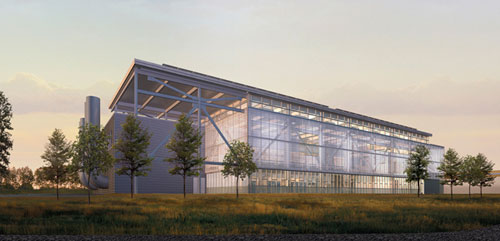The Living Lab
< page 3 >
The hallmark research space of the center is the Total Indoor Environmental Quality (TIEQ) laboratory that is designed to evaluate human response to indoor comfort factors. "Anything to do with indoor environments can be tested there," Bogucz says. "We can very carefully control temperature, humidity, air quality, lighting, and sound while studying human response to these factors." Where human subjects aren't practical for health or comfort reasons (such as measuring air flow and contaminants from one office cubicle to another), the lab technicians use thermal mannequins to simulate an occupied space. The more advanced of these mechanical stand-ins have multiple zones that can produce heat and moisture, and simulate breath.
A research feature that's visible from the exterior is the facade "test bed." (The term test bed refers to a functional mock-up.) It consists of an 8-foot-wide by 16-foot-high knockout panel on the south elevation of the building into which different wall systems can be inserted and evaluated. A solar concentrating facade that can provide electricity, heat, and daylight is currently being tested.
The facility accommodates a panoply of departments and disciplines. "It was always our intention that the building be a place to engage scholars and practitioners from multiple disciplines," Bogucz states. "We like to say that the building is like a gym—people are going to come and work out." Joining the mix are some 200 industry partners whose business is to develop products and services.
The Flexible Research Facility
The Carbon Neutral Energy Solutions Laboratory at Georgia Institute of Technology in Atlanta will focus on pilot-scale research for the development of carbon-neutral technology when it's completed this fall. The 42,000-square-foot building is designed to be carbon-neutral as defined by its target of net-zero site energy status. The energy and carbon targets are ambitious, given the extreme energy-intensive requirements of research laboratories.
"When we presented the idea of carbon neutrality for the building and having it meet the 2030 Challenge, the institute immediately latched on to the idea," says Princeton Porter, senior project designer for HDR Architecture. The main tenet of the 2030 Challenge eliminate fossil fuel energy use in buildings by 2030.
Laboratories can be one of the most difficult structures to make efficient, consuming ten times the energy per square foot of an office. "We broke the program down and assigned temperature and humidity targets for each space, rather than for the whole building," Porter says. The design team then compiled a list of possible strategies that compared energy savings, life cycle costs, and first costs. Using energy modeling, the designers determined which strategies would be most effective by weighing short- and long-term benefits and costs.
Spatial flexibility is critical when considering a test bed-type facility. The building is designed as an elongated box with a 40-foot-tall "high-bay" lab along the north side. The south half of the building has office area on the upper level and a mid-bay lab on the ground floor. This arrangement allows the structure to accommodate an array of potential uses. The high-bay lab has an industrial overhead crane that can move large pieces of equipment without disrupting the experiments below. A series of transparent garage-type doors facilitates the crane's ability to slide equipment horizontally into the adjacent mid-bay structure. The openings also allow experiments to expand into the larger space as they grow.
 |
Georgia Tech's Carbon Neutral Energy Solutions Lab Photo courtesy HDR Inc. |









